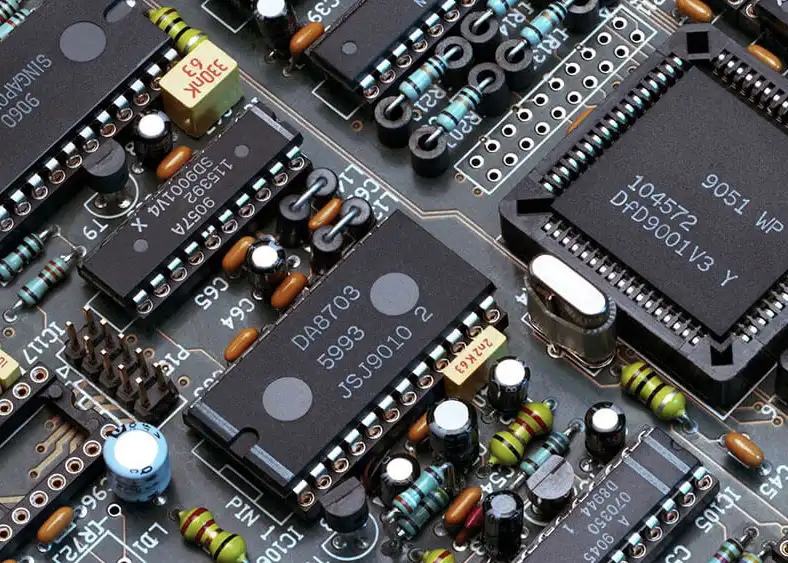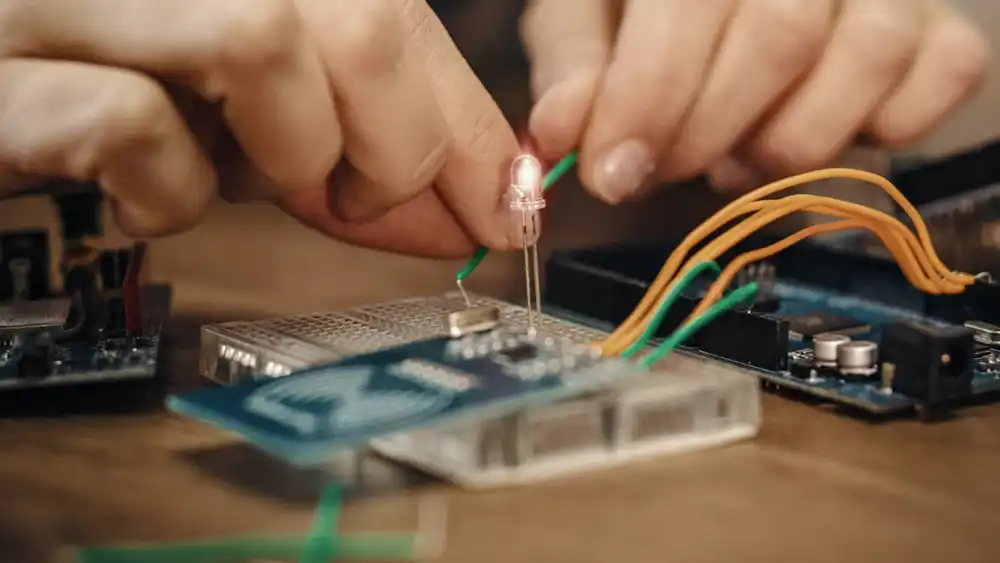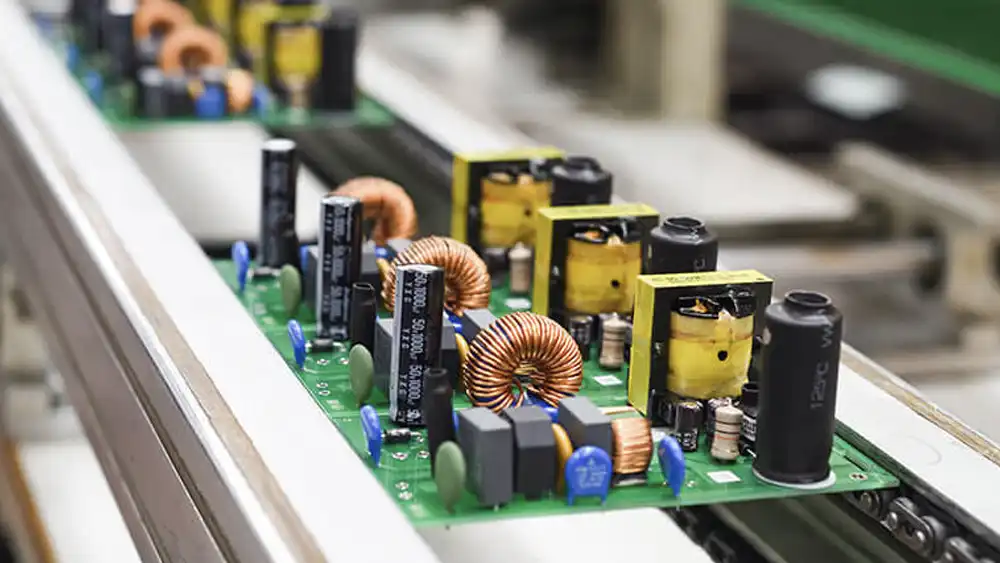Due to their wide applications, Electronic components play an increasingly important role in the electronic industry.
In this blog post, we are going to know how to manufacture electronic components step by step.
Electronic Components

Electronic components are fundamental building blocks in various electronic devices, ranging from smartphones to complex machinery. These components play a crucial role in facilitating the flow of electricity within circuits, enabling the functionality of electronic systems. Understanding how to make electronic components is essential for individuals or companies involved in electronics manufacturing.
Types of Electronic Components

Electronic components encompass various devices, including resistors, capacitors, diodes, transistors, and integrated circuits (ICs). Each component serves a unique purpose within an electronic circuit, such as regulating voltage, storing energy, or amplifying signals.
Here is a list of common types of electronic components:
- Resistors
- Capacitors
- Diodes
- Transistors
- Integrated Circuits (ICs)
- Inductors
- Relays
- Sensors
- Switches
- Connectors
- Batteries
- LEDs (Light Emitting Diodes)
- Oscillators
- Potentiometers
- Transformers
These components serve various functions within electronic circuits and devices, including controlling voltage, storing energy, amplifying signals, and regulating current flow.
Basic Principles of Making Electronic Components

Exploring the basic principles of making electronic components involves understanding the fundamental concepts and processes involved in their fabrication.
Here are some key points:
- Materials Selection: The choice of materials is critical in electronic component manufacturing. Materials with specific electrical, thermal, and mechanical properties are selected to meet the component’s performance requirements. Common materials include silicon, metals, ceramics, and polymers.
- Design: Electronic components are designed using computer-aided design (CAD) software. Designers create detailed schematics and layouts that specify the component’s dimensions, materials, and functionality. The design phase also involves considering factors such as size, shape, and electrical characteristics.
- Fabrication Techniques: Once the design is finalized, fabrication processes begin. These processes vary depending on the type of component but often include techniques such as photolithography, chemical etching, deposition, and assembly. Fabrication transforms raw materials into intricate electronic structures following precise patterns and dimensions.
- Photolithography: Photolithography is a key process used in semiconductor manufacturing to transfer the component’s design onto a silicon wafer. It involves applying a light-sensitive photoresist material to the wafer’s surface, followed by exposure to ultraviolet light through a mask containing the desired pattern. The exposed areas of the photoresist are chemically treated to create the pattern on the wafer.
- Etching: Etching is a process used to remove material from the wafer’s surface selectively. Chemical etchants or plasma etching techniques are employed to dissolve or ablate material from the areas not protected by the photoresist mask, leaving behind the desired patterned features.
- Deposition: Deposition involves depositing thin layers of material onto the wafer’s surface using techniques such as chemical vapor deposition (CVD) or physical vapor deposition (PVD). These layers may serve various purposes, such as forming conductive traces, insulating layers, or semiconductor junctions.
- Assembly: After the individual components are fabricated, they are assembled onto substrates or packages to form complete electronic devices. Assembly processes may include soldering, wire bonding, or flip-chip bonding, depending on the component type and application.
- Testing and Quality Control: Throughout the manufacturing process, electronic components undergo rigorous testing and quality control procedures to ensure functionality, reliability, and consistency. Testing may involve electrical, thermal, mechanical, and environmental assessments to identify defects, ensure performance specifications are met, and validate reliability under various operating conditions.
By adhering to these basic principles and employing advanced manufacturing techniques, electronic component manufacturers can produce high-quality components that drive innovation and advancement in the electronics industry.
Step-by-Step Guide to Making Electronic Components

Here’s an explanation of the step-by-step guide to making electronic components:
Step 1: Designing the Component:
The first step in making electronic components is designing the component’s specifications and characteristics. Engineers use computer-aided design (CAD) software to create detailed schematics and layouts. During this phase, designers consider factors such as the component’s function, size, shape, material compatibility, and electrical properties.
Step 2: Selecting Materials:
Once the design is finalized, the next step is selecting appropriate materials for the component. The choice of materials depends on the component’s intended function, operating conditions, and manufacturing process. Common materials used in electronic component manufacturing include silicon, metals, ceramics, and polymers.
Step 3: Fabrication Techniques:
After materials selection, the fabrication process begins. Fabrication techniques vary depending on the type of component being produced but may include processes such as photolithography, etching, deposition, and assembly. These processes transform raw materials into intricate electronic structures following precise patterns and dimensions.
Step 4: Photolithography:
In semiconductor manufacturing, photolithography is a crucial step used to transfer the component’s design onto a silicon wafer. This process involves applying a light-sensitive photoresist material to the wafer’s surface, followed by exposure to ultraviolet light through a mask containing the desired pattern. The exposed areas of the photoresist are then chemically treated to create the pattern on the wafer.
Step 5: Etching:
Etching is a process used to selectively remove material from the wafer’s surface. Chemical etchants or plasma etching techniques are employed to dissolve or ablate material from areas not protected by the photoresist mask, leaving behind the desired patterned features.
Step 6: Deposition:
Deposition involves depositing thin layers of material onto the wafer’s surface using techniques such as chemical vapor deposition (CVD) or physical vapor deposition (PVD). These layers may serve various purposes, such as forming conductive traces, insulating layers, or semiconductor junctions.
Step 7: Assembly:
Once the individual components are fabricated, they are assembled onto substrates or packages to form complete electronic devices. Assembly processes may include soldering, wire bonding, or flip-chip bonding, depending on the component type and application.
Step 8: Testing and Quality Control:
Throughout the manufacturing process, electronic components undergo rigorous testing and quality control procedures to ensure functionality, reliability, and consistency. Testing may involve electrical, thermal, mechanical, and environmental assessments to identify defects, ensure performance specifications are met, and validate reliability under various operating conditions.
By following this step-by-step guide, electronic component manufacturers can produce high-quality components that meet performance requirements and contribute to the advancement of electronic devices and systems.
Challenges in Making Electronic Components
Precision and Accuracy
The production of electronic components demands high levels of precision and accuracy to meet stringent performance requirements. Small deviations or errors during manufacturing can compromise the functionality and reliability of the components.
Cost-Effectiveness
Balancing cost-effectiveness with quality is a significant challenge in electronic component manufacturing. Companies must optimize production processes and material usage to minimize costs while maintaining product integrity and performance.
Technological Advancements
The rapidly evolving field of electronics presents challenges and opportunities for electronic component manufacturers. Keeping pace with technological advancements requires continuous innovation and investment in research and development.
Tips for Successful Electronic Component Production
Research and Development
Investing in research and development is crucial for staying ahead in the competitive electronics industry. Companies must explore emerging technologies and market trends to develop innovative solutions and improve existing products.
Collaboration and Innovation
Collaboration between manufacturers, suppliers, and customers fosters innovation and enhances product development processes. By leveraging collective expertise and resources, companies can streamline production and deliver cutting-edge electronic components.
Conclusion
In conclusion, understanding how to make electronic components is essential for the electronics industry’s advancement and innovation. By adhering to rigorous manufacturing processes, embracing technological advancements, and fostering collaboration and innovation, manufacturers can produce high-quality components that drive the evolution of electronic devices.
FAQs
What is the significance of quality control in electronic component manufacturing?
Quality control ensures that electronic components meet predefined standards and specifications, guaranteeing reliability and performance in end-user applications.
How do environmental factors impact electronic component production?
Environmental factors such as temperature, humidity, and contamination can affect the quality and consistency of electronic component manufacturing processes, necessitating controlled environments and preventive measures.
What are some emerging trends in electronic component manufacturing?
Emerging trends in electronic component manufacturing include miniaturization, flexible electronics, additive manufacturing, and sustainable practices aimed at reducing environmental impact.
How do manufacturers address counterfeit electronic components in the supply chain?
Manufacturers implement stringent supply chain management practices and authentication technologies to detect and prevent the proliferation of counterfeit electronic components, safeguarding product integrity and consumer safety.
What role do regulations and standards play in electronic component manufacturing?
Regulations and standards govern various aspects of electronic component manufacturing, including safety, quality, and environmental compliance, ensuring adherence to industry best practices and regulatory requirements.